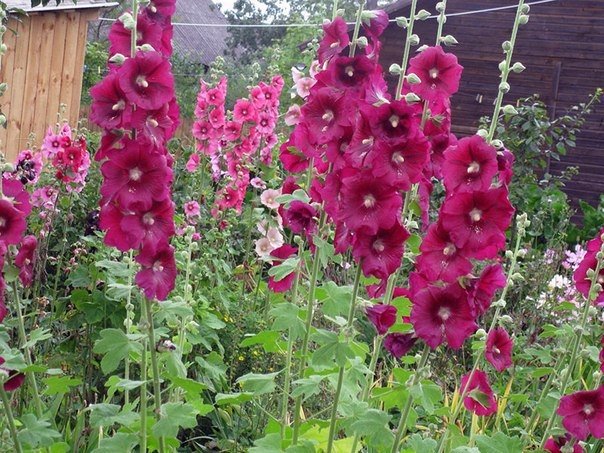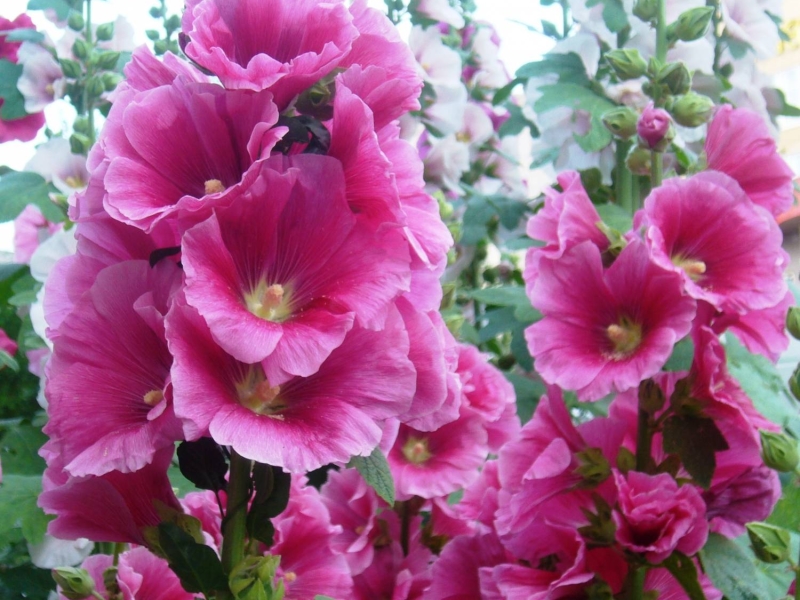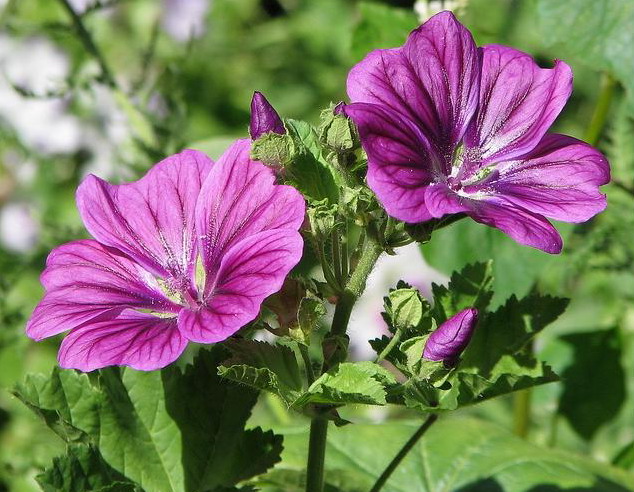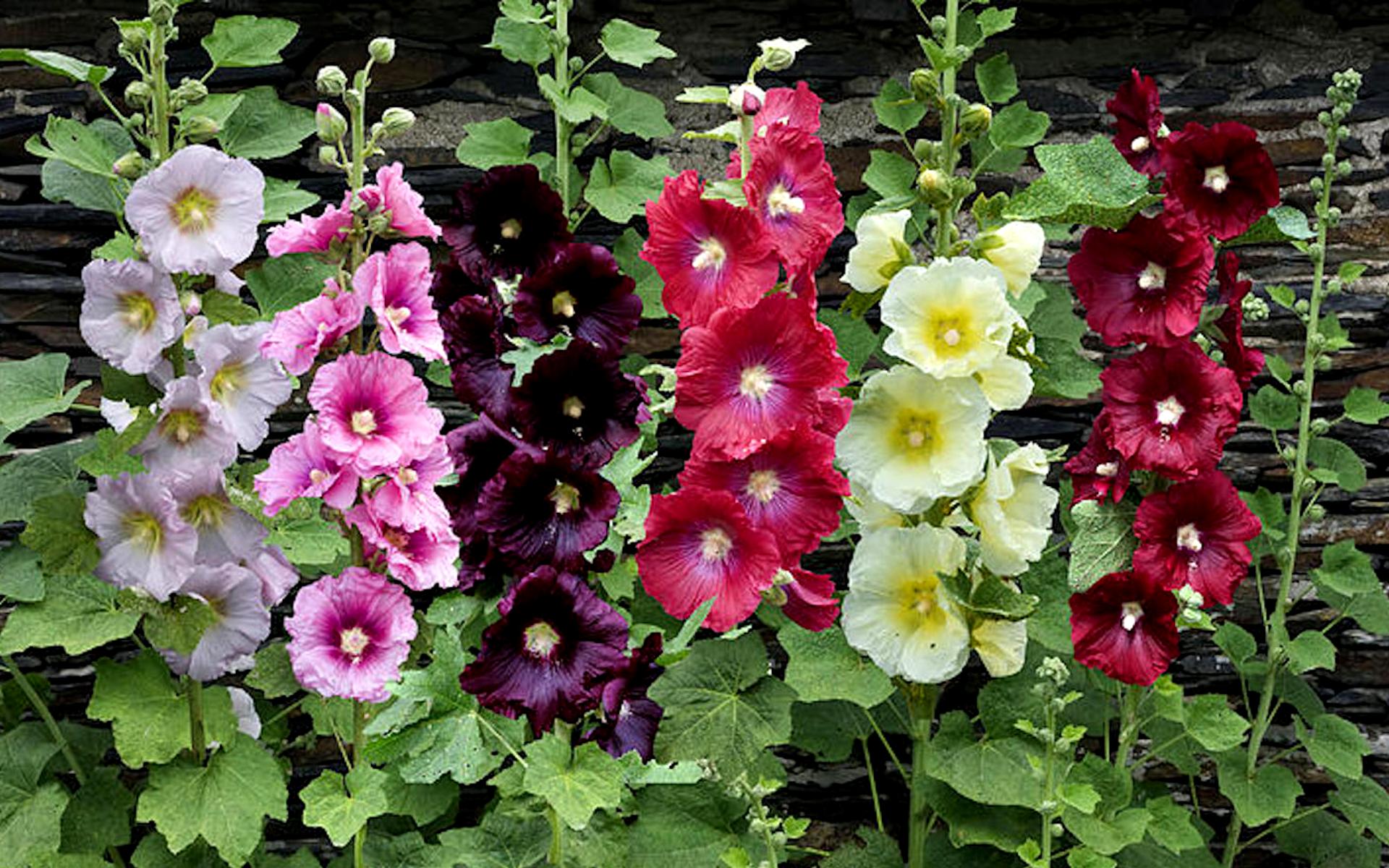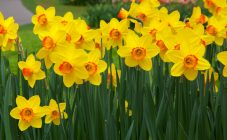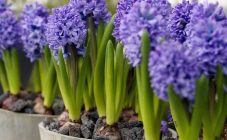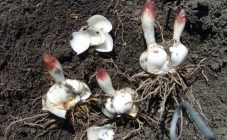Content:
When choosing perennials for a flower bed, remember about mallow. Growing a beautiful and spectacular plant will decorate any front garden. Both experienced and novice growers like mallow for perennial planting with seeds. A perennial flower with a long history looks great in the garden decor of small summer cottages and luxury cottages. The plant represents the sun and summer, charm and luxury, peace and restraint. Some summer residents are interested in how they plant mallow seeds in open ground.
Perennial mallow
Mallow belongs to herbaceous perennials that represent the mallow family. People call mallow:
- kalachik;
- stockrose;
- mallow.
The height of an erect tall flower varies in the range of 0.8-2.5 m. In its natural environment, it grows in the temperate climate of Europe, in the Asian and North American regions, and lives in Africa.
Rounded leaflets have notched edges. The dimensions of the foliage are determined by the location. At the bottom of the stem, the leaves are larger, their size decreases as they rise up. Funnel-shaped flowers with a diameter of 6-12 cm are simple and double, as well as semi-double. Coloring of buds:
- snow-white and pink;
- red and orange and more.
At the end of flowering, a fruit is formed on the culture - a dense ring, which, when ripe, breaks up into slices. The seeds remain viable for 2-3 years. In the first year, the mallow forms a leaf rosette. The plant will bloom next season.
The peak of decorativeness of mallow falls in June and continues until the arrival of autumn.
Plant propagation methods:
- seeds;
- by cuttings.
Propagation through seedlings or directly by direct seeding into the ground is how to plant mallow with seeds. Seedling sowing occurs at the end of winter or March - mallow can bloom in the middle of summer. Separate peat bowls are used to prevent transplanting. Seeds planted in one container are intertwined with roots and are severely damaged when diving.
For seedlings, the south side on the windowsill or a glazed balcony is suitable. Lack of light is the reason for stretching seedlings, diseases, long acclimatization in unprotected soil.
Sprout care consists in periodic watering. Feeding and spraying seedlings will not be required.
Mallow is tentatively planted in a permanent place in May, after frost. The planting scheme is influenced by the characteristics of the variety and the design of the flower bed.
In the garden, mallow is easy to care for. After weeding the flower garden, carefully loosen the soil near the bushes. For the attractiveness of the culture, cut off the faded stems with a pruner.
Agrotechnics of growing mallow
Mallow is an unassuming plant. But in order to grow a luxurious bush, it is important to adhere to the basic rules.
Seat selection
For a perennial, a front garden is preferable, which is well illuminated by sunlight and is not blown through by drafts. Growth in partial shade will affect poor flowering and splendor, a decrease in shoot growth.
It is required to plant flower plantations with a support: at a fence or pergola.
The soil
Mallow is grown on soil that meets the following requirements:
- Contains sufficient moisture with good drainage.
- Loams rich in humus are suitable. They improve the structure of clay by adding humus and sand, sandy loam - humus, clay or peat.
- Digging the soil is carried out on a shovel bayonet, weeds are selected.
- When digging, the earth is fertilized with ash, humus or rotted compost.
Sowing seeds in open ground
As a rule, mallow is sown in the last decade of May and June. Seed material is distributed on the surface of the dug up beds and sprinkled with soil.
Mallow planting seeds in the ground is carried out according to the scheme, observing the interval between crops:
- tall - 50-70 cm;
- undersized - 40-45 cm.
Sometimes shallow grooves are made in the soil and seeds are placed.
To avoid the death of seeds during the heat, the soil is systematically moistened before sprouts appear.
Plant shoots usually appear on days 14-21. Thickened plantings are thinned out, seedlings, if necessary, are transferred to another flower bed.
Sowing time
It is important for gardeners to know when to plant mallow. The plant is sown twice: in spring and also in autumn. Flowering will come only next year. The optimal timing for spring planting is when the threat of return cold has passed. In the case of perennial mallow, planting seeds in autumn is carried out in September-October, before the arrival of stable frosts.
Transplanting
The seedling method is considered more reliable. Seeds are usually sown at the end of February. In advance, the seeds are soaked in a damp cloth for 12 hours.
Spacious cups are prepared for seed material - mallow roots will need space. The containers are filled with soil mixture. You can use a special soil for flowers. The use of peat pots is desirable.
The technological process of sowing seeds does not differ from planting in the ground. A couple of seeds are placed on top of the ground and sprinkled lightly with soil. Then individual cassettes are spilled with water. In order for flower plants to develop normally, the glasses are kept in a warm room with a temperature of at least + 18 ... + 22 ° C, they do not allow drafts and provide periodic watering.
Diving mallow into the soil is optional. If a pick is carried out, then it is carried out if there is a third true leaf on the seedlings and the mallow is grown in a container. The most powerful seedlings dive, which then develop in the greenhouse or at home with the support of a constant temperature regime and expect to be moved to a permanent site. Strong excess sprouts are placed in peat tablets if desired.
Sowing before winter
Summer residents are interested in how to plant mallow correctly in the fall. Pre-winter sowing involves sowing seeds in October. Several seeds are placed in the prepared holes, deepened by 3 cm. The distance between the holes is 40-45 cm. The holes are sprinkled with peat and earth. Plantings are mulched with opal leaves.
Mallow care
Watering
During drought in summer, plants extract water from the soil with long roots. It will not hurt to water densely flowering hybrid varieties in the absence of rain for at least 2 weeks.
Top dressing
Cultivation of mallow on nutritious soil does not require fertilization. The pale leaves of the plant in the spring indicate a nitrogen deficiency, which is replenished with complex feeding: 1 tbsp.on the bush. Fit ammophos, azophoska.
Spraying in summer on foliage before budding is carried out using Agricola or Ideal. This will give the flowering splendor.
Garter
It is difficult for tall plants to do without support, especially in abundantly flowering terry hybrid varieties - the stem cannot cope with the mass of inflorescences.
In the second year, a support is installed so as not to spoil the garden decor with pegs ahead of time. The soft material will help when tying the stalk. The support reaches the middle of the stem.
Pests and phyto-diseases
Mallow is often affected by slugs. Special traps are used to destroy them. On the flower plot, containers with beer are displayed. A day later, the baits are monitored and cleaned of parasites.
Aphids and spider mites settle on the plant. Insecticides are used to treat plants.
Mallow is resistant to disease. Landing near a metal fence provokes a rust infection. The disease is signaled by reddish spots on the inside of the leaves. Cutting and destruction of the affected leaf plates is carried out. The leaves are treated with a Bordeaux mixture.
Occasionally, the plant is sick with powdery mildew, which is generated by excessive moisture due to rainfall or excessive watering. To combat the disease, colloidal sulfur or fungicides Mikosan-V, Fito-Doctor are used.
Mallow after flowering
When the perennial has taken away, it is recommended to cut the stems to the ground level in the fall. They remember about fertilizing the soil and mulch with humus or compost: 3 kg per 1 m2.
Mallow seed collection and planting scheme
Mallow is a cross-pollinated flower. Therefore, collecting seeds from mallow, when sowing, hybrids with different colors are obtained.
Some summer residents prefer to use seeds that are collected in the fall with their own hands. The germination and growth of mallow depends on the quality of the seed.
Collecting seeds when they turn yellow is carried out from queen cells, which is selected depending on the type and purity of the variety. Seeds remain viable for three years. Ripening of mallow bolls and their opening is a signal for harvesting.
10 days is the period for drying the seed pods. Suitable air temperature for drying is + 25 ... + 30 ° С.
The seed is cleaned from foreign impurities. Havewords storage:
- temperature - +10 ° С;
- humidity - 50%.
Tips from experienced summer residents
Herbaceous perennial is characterized by unpretentious care, however, when growing it, experienced summer residents recommend paying attention to:
- Moderate watering and on not very dense soil, preferably light loam with a neutral pH.
- Avoid shaded beds. Lack of light threatens with the loss of decorativeness.
- Landing on blown areas is prohibited.
- Obligatory shelter during the onset of cold weather.
- Transplantation is undesirable. Mallow struggles to cope with root trauma and stress. When planting seedlings, it is better to use peat glasses.
- Mallows open up new possibilities in landscape design. Plants are suitable for country-style garden decoration and for creating separate zones. Great for group plantings.
Perennial mallow will adorn any front garden. In the old 2018, gardeners are thinking and planning flower planting for the next year. Quality mallow seeds will add elegance and grace to the garden area. The lunar landing will help the dream come true.
